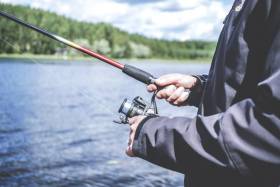Displaying items by tag: Lough na Tooey
Creeslough & District Angling Association yesterday (Monday 17 June) opened its new angling facility at Lough na Tooey in North Donegal.
The facility, which was co-funded by Inland Fisheries Ireland (IFI) through its National Strategy for Angling Development, was officially launched by Sean Canney, Minister of State with responsibility for inland fisheries.
The facility at Creeslough is one aspect of a development project delivered by the local angling group which manages a number of salmon and trout fisheries in the area.
This project saw the improvement of angling access and infrastructure across three sites in the area: Lough na Tooey, Glen Lough and the Owencarrow River.
New facilities at Lough na Tooey include a slipway and mooring pontoon, boatshed and car park.
At Glen Lough, a new improved roadway over 1.2km leading to the angling site was constructed, while at Owencarrow, 15 stiles and ladders and 33 fishing stands were erected over 300m of the river bank.
IFI provided funding of over €216,000 with Creeslough & District Angling Association providing match funding of €30,000 to enable the completion of the project.
Minister Canney welcomed the project’s completion, saying: “The new facilities will enable safe and easier access to the fishery for the local community, while also supporting tourism in North Donegal.
“This is a first-class angling site located in a county renowned for its beautiful scenery and superb angling resource. As a result of this project, more local and visiting anglers will be fishing in the area, which in turn will provide both recreational and economic benefits for the community.”
IFI chief executive Dr Ciaran Byrne noted that Creeslough & District Angling Association “initiated and delivered these facilities on the ground by taking a collaborative approach and working across their entire fishery to identify where improvements were needed.
“Rural communities are engaging around the angling resource and demand for support continues apace. We look forward to partnering with more clubs and associations on the delivery of fisheries projects and will announce those successful in securing funding from our latest funding call over the coming months.”
Paddy Boyle of the Creeslough & District Angling Association said: “Fishing as a sport and recreation is dependent on the quality of the natural environment around us. Angling clubs have a role as custodians of this wonderful resource, and we owe it to future generations to look after the fish and their habitat.
“This development at Creeslough is proof of what angling clubs can achieve in partnership with local development agencies and Inland Fisheries Ireland. We asked for their help and got it because we presented them with a well thought-out plan for the conservation and development of our fisheries.”






























































